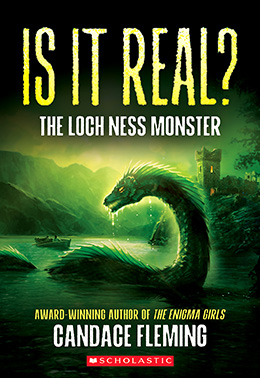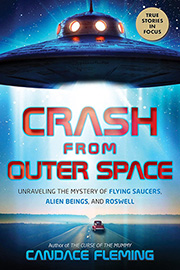BOOKS

Scholastic Focus
March 4, 2025
978–1546110286
Ages 8 and up
buy the book
hardcover
paperback
e‑book
audio book
After you’ve read Is It Real? The Loch Ness Monster, try this book:
Is It Real? The Loch Ness Monster
Put on your detective hat and prepare all your investigative tools, because you’ve been assigned a new case to solve: the mystery of the Loch Ness Monster!
Is it an otter? Is it a seal? Is it a log? Or is it a monster, lurking beneath the surface? Dive in, and you may just find out…
Nestled in the hills of Scotland lies Loch Ness, a deep, murky lake with a long, storied history. But we know it as the home of the Loch Ness Monster, a mysterious creature that has long captivated the imaginations of people around the world.
In 1933, the most well-known article detailing an eyewitness account of the Loch Ness Monster was published, gaining immediate public attention. Since then, numerous articles have been published by people claiming to have seen the legend, a creature described as looking like a dinosaur or dragon. Then, in 1934, the first photographs of the creature were released. The race was on to uncover the truth. Decades later, after numerous expeditions, documentaries, firsthand accounts, pictures, and videos, the world still questions the existence of this monster.
Now, Sibert Award-winning author Candace Fleming uses all of her nonfiction tools, investigatory skills, and storytelling prowess to dive into the legend. Follow along as she considers the evidence and tries to discern between fact and fiction, all in hopes of finding the answer to the question that has long inspired the world: is the Loch Ness Monster fact, or fiction?
Reviews
“Fleming approaches the Loch Ness monster question with a well-organized collection of evidence for readers to evaluate, practical ways of doing so, and an attitude of skepticism. In the book’s fictional framework, the reader, “an investigator for the Black Swan (BSSI) investigative team,” receives an envelope full of interviews, news articles, and other documents related to Nessie, the Loch Ness monster, and one question to answer: “Is it real?” Addressing the reader in second person, Fleming offers advice on types of evidence and how to evaluate them. Although several photos were taken of “monsters” in Loch Ness, they did not prove Nessie’s existence. The book’s black-and-white illustrations include many photos and a few pertinent drawings. From the first sightings in 1933 to the arrival of a famous big-game hunter (who incorrectly identified a hippopotamus footprint as that of the monster) to Fleming’s warning to doubt any evidence leading to conclusions that you particularly want, this well-organized book offers an opportunity to learn about the Loch Ness Monster while becoming more skilled and skeptical when evaluating so-called experts and opinions voiced as facts. In short, this account of the history of Loch Ness monster sightings and theories is entertaining, informative, and useful for practical applications as well.” (Carolyn Phelan, Booklist, starred review)


